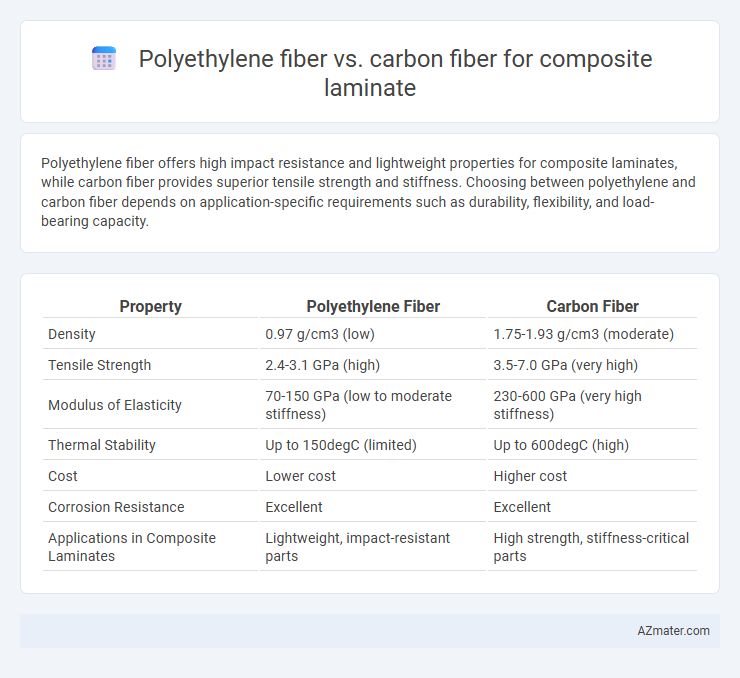Polyethylene fiber offers high impact resistance and lightweight properties for composite laminates, while carbon fiber provides superior tensile strength and stiffness. Choosing between polyethylene and carbon fiber depends on application-specific requirements such as durability, flexibility, and load-bearing capacity.
Table of Comparison
| Property | Polyethylene Fiber | Carbon Fiber |
|---|---|---|
| Density | 0.97 g/cm3 (low) | 1.75-1.93 g/cm3 (moderate) |
| Tensile Strength | 2.4-3.1 GPa (high) | 3.5-7.0 GPa (very high) |
| Modulus of Elasticity | 70-150 GPa (low to moderate stiffness) | 230-600 GPa (very high stiffness) |
| Thermal Stability | Up to 150degC (limited) | Up to 600degC (high) |
| Cost | Lower cost | Higher cost |
| Corrosion Resistance | Excellent | Excellent |
| Applications in Composite Laminates | Lightweight, impact-resistant parts | High strength, stiffness-critical parts |
Introduction to Composite Laminates
Composite laminates are engineered materials composed of multiple bonded layers, combining fibers and matrices to optimize mechanical properties. Polyethylene fiber offers lightweight and high impact resistance, making it ideal for ballistic and protective applications, while carbon fiber provides superior stiffness, tensile strength, and thermal stability favored in aerospace and automotive industries. The choice between polyethylene and carbon fiber in composite laminates depends on application-specific demands such as weight, flexibility, strength, and environmental resistance.
Overview of Polyethylene Fiber
Polyethylene fiber, notably ultra-high-molecular-weight polyethylene (UHMWPE), is valued in composite laminates for its exceptional strength-to-weight ratio, high impact resistance, and chemical inertness. This fiber features low density (approximately 0.97 g/cm3), superior tensile strength (up to 3 GPa), and excellent energy absorption, making it suitable for ballistic protection and lightweight applications. Compared to carbon fiber, polyethylene fiber offers greater flexibility and impact toughness but has lower stiffness and thermal stability.
Overview of Carbon Fiber
Carbon fiber offers superior strength-to-weight ratio and stiffness compared to polyethylene fiber, making it ideal for high-performance composite laminates in aerospace and automotive industries. Its carbon atoms are tightly bonded in a crystalline structure, providing excellent tensile strength and thermal stability. These properties result in composites with enhanced durability, fatigue resistance, and minimal deformation under stress, outperforming polyethylene fiber in structural applications.
Mechanical Properties Comparison
Polyethylene fiber offers high tensile strength and excellent impact resistance in composite laminates, making it suitable for applications requiring flexibility and energy absorption. Carbon fiber provides superior stiffness, tensile modulus, and fatigue resistance, resulting in significantly higher load-bearing capacity and structural rigidity compared to polyethylene fiber composites. Mechanical property comparison reveals carbon fiber laminates excel in strength-to-weight ratio and dimensional stability, while polyethylene fiber laminates outperform in toughness and vibration damping.
Weight and Density Differences
Polyethylene fiber has a significantly lower density, typically around 0.97 g/cm3, compared to carbon fiber's density of approximately 1.75-1.93 g/cm3, making polyethylene fiber composites lighter in weight. This difference in density influences the weight-to-strength ratio, where carbon fiber provides higher stiffness and strength but at a heavier weight per unit volume. Choosing between polyethylene and carbon fiber for composite laminates depends on balancing the need for ultra-lightweight materials versus higher mechanical performance.
Durability and Environmental Resistance
Polyethylene fiber composite laminates exhibit superior durability due to their high impact resistance and excellent fatigue life, making them ideal for applications requiring long-term mechanical stability. Carbon fiber composites, while extremely strong and stiff, are more susceptible to environmental degradation such as UV exposure and moisture absorption, which can reduce their lifespan without protective coatings. Polyethylene's inherent resistance to chemicals, moisture, and abrasion enhances its environmental resilience compared to carbon fiber, positioning it as a preferred choice for harsh and corrosive environments.
Cost Analysis and Availability
Polyethylene fiber offers a significantly lower cost compared to carbon fiber, making it an economical choice for composite laminates in budget-sensitive applications. Carbon fiber, though more expensive due to complex manufacturing and raw material costs, provides superior stiffness and strength but faces limited availability in some regions. Polyethylene fiber benefits from widespread production and ease of sourcing, ensuring consistent supply, whereas carbon fiber availability can fluctuate with demand and specialized processing capacity.
Applications in Industry
Polyethylene fiber composites are widely used in ballistic protection, ropes, and marine applications due to their high impact resistance and lightweight properties. Carbon fiber composites dominate aerospace, automotive, and sporting goods industries for their superior stiffness, tensile strength, and thermal stability. The choice between polyethylene and carbon fiber laminates depends on specific application requirements such as weight, durability, and cost efficiency.
Manufacturing and Processing Ease
Polyethylene fiber offers superior manufacturing ease due to its low melting point and excellent chemical resistance, allowing simpler molding and processing techniques compared to carbon fiber. Carbon fiber requires precise temperature control and complex curing processes, often involving autoclaves, which increases production time and costs. The inherent flexibility of polyethylene fibers also facilitates easier handling and weaving, enhancing composite laminate fabrication efficiency.
Conclusion: Choosing the Right Fiber for Composites
Polyethylene fiber offers superior impact resistance and flexibility, making it ideal for applications requiring lightweight and energy absorption. Carbon fiber provides exceptional stiffness and tensile strength, suitable for high-performance structural components. Selecting the right fiber depends on the specific mechanical demands and environmental conditions of the composite laminate application.

Infographic: Polyethylene fiber vs Carbon fiber for Composite laminate
 azmater.com
azmater.com